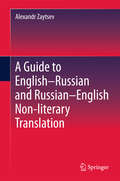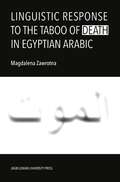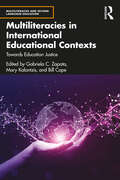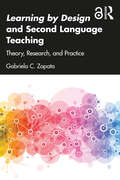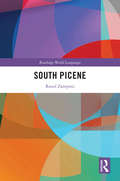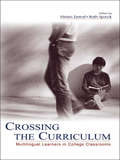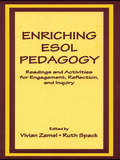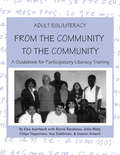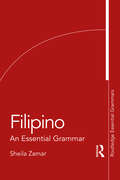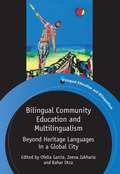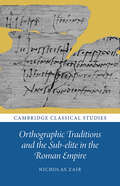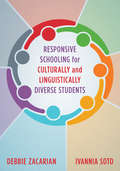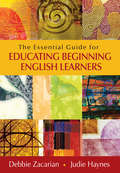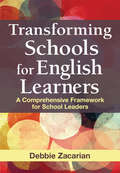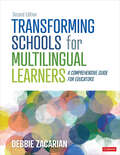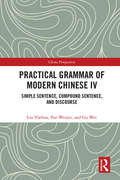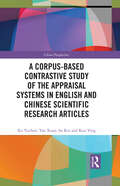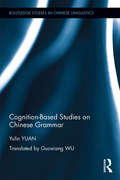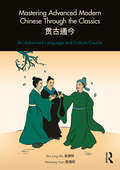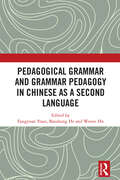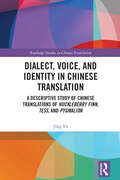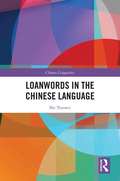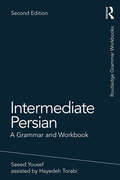- Table View
- List View
A Guide to English-Russian and Russian-English Non-literary Translation
by Alexandr ZaytsevLying at the intersection of translatology, cognitive science and linguistics, this brief provides a comprehensive framework for studying, investigating and teaching English-Russian/Russian-English non-literary translation. It provides a holistic perspective on the process of non-literary translation, illustrating each of its steps with carefully analyzed real-life examples. Readers will learn how to choose and process multidimensional attention units in original texts by activating different types of knowledge, as well as how to effectively devise target-language matches for them using various translation techniques. It is rounded out with handy and feasible recommendations on the structure and content of an undergraduate course in translation. The abundance of examples makes it suitable not only for use in the classroom, but also for independent study.
Linguistic Response to the Taboo of Death in Egyptian Arabic
by Magdalena ZawrotnaThe work presents a study of the linguistic and pragmatic response to the taboo of death in Egypt. The analysis leads the author to the conclusion that the experience of death in Egyptian society is mediated by religion. The reaction to death announcements includes a number of strategies to protect both the author of the utterance and its recipient against the effects of the taboo related to this topic. The most important feature of the studied communication is formulaicity, which is at the same time the central idea and the methodological frame of the work presented here.The discourse analyzed here fits within the Arab-Muslim rhetorical framework. In the daily utterances of the Egyptians, divine agency is believed to be constantly present, which is attested in numerous ritual practices. As part of the quantitative study and the structural analysis of the material, a pattern was distinguished in which individual types of formulas occur in their fixed places and a specific order. Qualitatively, many of the statements in the material are strongly emotional. To enhance the pragmatic effect, phrases are combined with each other, repetitions, prayers, poetic attempts and quotes from the Quran/ Hadith appear. Most of the phrases used in response to the taboo of death are prefabricated items recalled from memory almost automatically. Further analysis proposes to look at the formulae in the context of taboo and strong emotions related to it. Using formulaic sequence instead of generating novel language enables. the author of the utterance to convey emotional support to the suffering person and, at the same time, eliminates ambiguity. The methodology proposed here offers a new insight into the language of everyday communication, through the lens of its pragmatic usefulness and linguistic etiquette, taking into account the cultural framework in which the analyzed utterances are performed.
Multiliteracies in International Educational Contexts: Towards Education Justice (Multiliteracies and Second Language Education)
by Gabriela C. Zapata Mary Kalantzis Bill CopeMultiliteracies in International Educational Contexts: Towards Education Justice examines how multiliteracies and Learning by Design have been taken up across international second-language instructional contexts, with a focus on inclusive practices and social justice. This edited collection brings together a team of international contributors to offer a global perspective on the application of multiliteracies in L2 education. Through the analysis of classroom-based qualitative and quantitative data on different aspects of the multiliteracies pedagogy, the book shows how the multiliteracies pedagogy can facilitate more inclusive practices while providing suggestions for pedagogical interventions and future research. This book will be a key resource for language educators, researchers, and practitioners interested in the multiliteracies pedagogy, as well as those interested in critical and social justice approaches to language teaching.
Learning by Design and Second Language Teaching: Theory, Research, and Practice
by Gabriela C. ZapataLearning by Design and Second Language Teaching establishes theoretical, research, and practice connections between the multiliteracies framework Learning by Design and L2 teaching and learning. A comprehensive introductory chapter presents the theoretical tenets of the approach and is followed by four chapters devoted to the establishment of connections between the framework and L2 instruction, information on evidence-based pedagogical practices and suggestions for their implementation, and task examples that can be adapted for use in a variety of educational contexts. Each chapter links theory and research to practical steps instructors can take to select authentic materials and create tasks in each of the framework’s knowledge processes with the objective of developing L2 students’ performance in the interpersonal (speaking), interpretive (reading and listening), and presentational (writing) modes of communication. A selection of guidance charts, figures, templates, and extra digital resources are included within the text to support learning and teaching. The book will be of interest to graduate students and in-service and future L2 teachers in all levels of instruction. Chapter 1, Chapter 2 and Chapter 3 of this book are freely available as a downloadable Open Access PDF under a Creative Commons Attribution-Non Commercial-No Derivatives 4.0 license available at http://www.taylorfrancis.com.
South Picene (Routledge World Languages)
by Raoul ZamponiSouth Picene is the pre-Roman language spoken in the Adriatic sector of central Italy. This book presents a description of what we know about the structure of this language. South Picene is (together with Umbrian, Oscan, Latin, and Faliscan) one of the few members of the Italic branch of the Indo-European family and is also one of the European languages with the oldest existing texts (550 BCE). Besides a grammatical outline of the language, the book contains the linguistic (and often stylistic) analysis of all the 21 inscriptions that compose the South Picene epigraphic corpus and a word list. South Picene will be of interest to students and scholars of Indo-European languages, Italic languages, and in general, ancient languages of the Italian peninsula.
Crossing the Curriculum: Multilingual Learners in College Classrooms
by Vivian Zamel Ruth SpackAs college classrooms have become more linguistically diverse, the work of ESOL professionals has expanded to include research on the experiences of multilingual learners not only in ESOL courses but also in courses across the curriculum. At the same time that ESOL professionals are trying to understand the academic challenges that learners face beyond ESOL courses, faculty across the disciplines are trying to meet the challenge of teaching students of differing linguistic backgrounds. Crossing the Curriculum: Multilingual Learners in College Classrooms responds to these issues and concerns by capturing the complex and content-specific nature of students' and teachers' experiences and providing a nuanced understanding of how multilingual students' learning can be fostered and sustained. Crossing the Curriculum: Multilingual Learners in College Classrooms is unique in bringing together the perspectives of researchers, students, and teachers. These multiple lenses allow for a richly layered picture of how students and teachers actually experience college classrooms. Common themes and pedagogical principles resonate across the three distinct sections of the book:*Part One, "Investigating Students' Experiences Across the Curriculum: Through the Eyes of Classroom Researchers," consists of chapters written by ESOL and composition researchers who have investigated multilingual students' experiences in undergraduate courses across the curriculum.*Part Two, "Learning Across the Curriculum: Through Students' Eyes," consists of chapters written by two multilingual learners who chronicled their experiences as they crossed the curriculum over time.*Part Three, "Engaging Students in Learning: Through the Eyes of Faculty Across the Curriculum," consists of chapters written by faculty from several academic fields--Anthropology, Philosophy, Nursing, Literature, Sociology, and Asian American Studies--who discuss their own attempts to address the needs of multilingual learners in their classrooms.
Enriching Esol Pedagogy: Readings and Activities for Engagement, Reflection, and Inquiry
by Vivian Zamel Ruth SpackEnriching ESOL Pedagogy: Readings and Activities for Engagement, Reflection, and Inquiry is a collection of thought-provoking articles and activities designed to engage practicing and prospective ESOL teachers in an ongoing process of reflecting on, critically examining, and investigating theory and practice. Its twofold purpose is to provide a theoretical perspective and to offer ways for making the teaching of English to speakers of other languages (ESOL) meaningful for both teachers and learners. Underlying the activities and the readings themselves is the assumption that teachers need to play a role in exploring, shaping, and theorizing the work they do. The readings included represent a range of genres. They are informed by a common philosophical perspective about language acquisition and treat language teaching and learning holistically. The book is organized into five integrated units that: * raise questions about conventional notions of methods; * take into account the complicated nature of real classrooms; * provide theoretical principles for teaching that promotes language acquisition; * include rich descriptions of actual classroom experiences; and * question assumptions about language and literacy. Each set of readings begin with a "Before Reading" section and is followed by "Reflecting on the Readings," "Reading for Further Reflection," and "Suggested Projects for Inquiry" sections. This volume is a valuable resource for practicing and prospective teachers in the field of TESOL who work with diverse student populations--at all levels--in both mainstream and ESL/bilingual settings.
Adult ESL/Literacy From the Community to the Community: A Guidebook for Participatory Literacy Training
by Ana Zambrano Elsa Auerbach Byron Barahona Julio Midy Felipe VaqueranoAdult ESL/Literacy from the Community to the Community: A Guidebook for Participatory Literacy Training tells the story of a university-community collaboration to develop, implement, and evaluate a project designed to train immigrants and refugees as adult ESL and native literacy instructors in their own communities. Beyond the story of this one project, the book is also a clear and powerful explication of the underlying principles and premises of the program model it describes: community leadership development, a participatory approach to literacy instruction and instructor training, native language adult literacy instruction, and collaboration.
Filipino: An Essential Grammar (Routledge Essential Grammars)
by Maria Sheila ZamarFilipino: An Essential Grammar is a comprehensive and practical reference guide introducing the key grammatical forms and structures in the Filipino language. This book offers a detailed exploration of key phonological, morphological, and syntactic features of Filipino that are essential to achieving high levels of proficiency in the language. Across 14 chapters are concise explanations of important grammatical categories and linguistic features relevant in the description of Philippine languages, complemented by examples relevant for everyday conversations and easy-to-understand rules for navigating Filipino grammar. Taking into consideration the most salient grammatical aspects that need to be presented by teachers and mastered by learners of Filipino, this is the ideal reference grammar for researchers, teachers, and learners of the Filipino language. This book is designed for both independent and class-based studies by learners of Filipino at all levels.
Lasai, ez da ezer gertatzen
by Ana Malagon ZalduaBakardadearen mapa moduko bat da liburu hau, Iban Zalduak hitzaurrean dioenez. Frustrazioaren koordenadak erakusten dizkigu bere orrietan, insatisfazioaren eta inkomunikazioaren kartografia. 162 mikroipuin idatzi ditu egileak, inoiz orria gainditu gabe, eta neurri murritz horretan unibertso pertsonal bat eraiki du: hiritarra, gaurkoa, gure egunerokotasunari ironiazko begirada bat eskaintzen diona. Haurtzaroa ageri da kontakizunotan, ez idealizatua baizik porrot txikiz osatua; heriotza ez tragikoa baizik eta ia etxekoa, misteriotsu baina aldi berean irrigarria; maitasun ez poz betezko baizik ahitua, askotan jaio orduko usteldua. Idazkera sobrio eta zehatza darabil Malagonek, apaingarriei eta enfasiei ihes egiten diena, eta ?bistan denez? luzamendutan galtzen ez dena.
Bilingual Community Education and Multilingualism
by Zeena Zakharia Ofelia GarcíaThis book explores bilingual community education, specifically the educational spaces shaped and organized by American ethnolinguistic communities for their children in the multilingual city of New York. Employing a rich variety of case studies which highlight the importance of the ethnolinguistic community in bilingual education, this collection examines the various structures that these communities use to educate their children as bilingual Americans. In doing so, it highlights the efforts and activism of these communities and what bilingual community education really means in today's globalized world. The volume offers new understandings of heritage language education, bilingual education, and speech communities for bilingual Americans in the 21st century.
Orthographic Traditions and the Sub-elite in the Roman Empire (Cambridge Classical Studies)
by Nicholas ZairThis book makes use of digital corpora to give in-depth details of the history and development of the spelling of Latin. It focusses on sub-elite texts in the Roman empire, and reveals that sophisticated education in this area was not restricted to those at the top of society. Nicholas Zair studies the history of particular orthographic features and traces their usage in a range of texts which give insight into everyday writers of Latin: including scribes and soldiers at Vindolanda, slaves at Pompeii, members of the Praetorian Guard, and writers of curse tablets. In doing so, he problematises the use of 'old-fashioned' spelling in dating inscriptions, provides important new information on sound-change in Latin, and shows how much can be gained from a detailed sociolinguistic analysis of ancient texts.
Responsive Schooling for Culturally and Linguistically Diverse Students
by Debbie Zacarian Ivannia SotoA strengths-based approach to making sure what we teach is central to who we teach. Rapidly changing and diverse student populations necessitate culturally responsive schooling. It can be a challenging balancing act for educators to respect diversity and teach to each student’s needs while adhering to restrictive curricula that mandate the use of standard English. Responsive Schooling for Culturally and Linguistically Diverse Students offers a balanced approach to developing students’ academic language proficiency while simultaneously honoring, acknowledging, and valuing the richness of their home and community languages and cultures. Debbie Zacarian and Ivannia Soto provide a practical framework within which schools and educators can make students’ personal, cultural, and social identities central to the curriculum by drawing on the experiences and interests they bring to the classroom. Filled with examples of responsive teaching and opportunities to reflect on current practice, the book is a rich resource for teachers and school leaders alike.
The Essential Guide for Educating Beginning English Learners
by Debbie Zacarian Judie HaynesPut all English learners on the path to success—right from the start! As more beginning ELs enroll in schools every year, educators need a realistic framework for addressing the varied needs of this growing population. In this practical resource, the authors provide templates, tools, and vignettes illustrating real-world challenges to help teachers and administrators: Learn strategies for teaching beginning level ELs across the curriculum Create a welcoming environment for students and families Reach out to students from both literacy and non-literacy-oriented homes Design programs that meet the needs of beginning ELs and students with limited or interrupted formal education (SLIFE)
Transforming Schools for English Learners: A Comprehensive Framework for School Leaders
by Debbie ZacarianPosition your school to successfully teach English learners Could your school be more effective at instructing its English learners? Whether you are just beginning to work with an emergent population or need to improve your program, this book provides a comprehensive framework for improving ELs’ academic performance and school engagement through visionary planning of EL education programming. The author addresses such critical topics as: Selecting the appropriate program model for your school Creating effective student course schedules for language development and content Making data-driven decisions using effective measures of student performance learning Effectively using Response to Intervention (RTI)
Transforming Schools for Multilingual Learners: A Comprehensive Guide for Educators
by Debbie ZacarianEssential principles, practices, and structures for multilingual learners Much has changed in the ten years since this book was first published. A celebrated triumph, it provided state, district, school, and teacher leaders with a comprehensive guide to support multilingual learners to reach their full potential. From selecting the appropriate program model to partnering with families and infusing federal and state laws governing the education of multilingual learners and the rights of their families into all we do, the key messages that made the first edition of this book a renowned success have been re-examined in the second edition with a robust lens to meet these demanding times. This second edition supports educators to design and enact policies, practices, and structures for multilingual learners (MLs) to feel a sense of safety, belonging, value, and competence. Topics explored in the book include: a discussion of the changes to federal and state policies and their impact on MLs and their families strategies to move from a deficit- to an asset-based approach that values multilingualism nine principles to design and deliver high-quality lessons in multiple languages and across disciplines practices to identify and support MLs with learning differences and disabilitiessteps for building long-lasting family-school partnerships Reflecting changing trends in leadership, this new edition supports superintendents, principals, curriculum supervisors, coaches, mentors, teachers, and other stakeholders in their collaborative efforts to create and sustain successful language assistance programs.
Transforming Schools for Multilingual Learners: A Comprehensive Guide for Educators
by Debbie ZacarianEssential principles, practices, and structures for multilingual learners Much has changed in the ten years since this book was first published. A celebrated triumph, it provided state, district, school, and teacher leaders with a comprehensive guide to support multilingual learners to reach their full potential. From selecting the appropriate program model to partnering with families and infusing federal and state laws governing the education of multilingual learners and the rights of their families into all we do, the key messages that made the first edition of this book a renowned success have been re-examined in the second edition with a robust lens to meet these demanding times. This second edition supports educators to design and enact policies, practices, and structures for multilingual learners (MLs) to feel a sense of safety, belonging, value, and competence. Topics explored in the book include: a discussion of the changes to federal and state policies and their impact on MLs and their families strategies to move from a deficit- to an asset-based approach that values multilingualism nine principles to design and deliver high-quality lessons in multiple languages and across disciplines practices to identify and support MLs with learning differences and disabilitiessteps for building long-lasting family-school partnerships Reflecting changing trends in leadership, this new edition supports superintendents, principals, curriculum supervisors, coaches, mentors, teachers, and other stakeholders in their collaborative efforts to create and sustain successful language assistance programs.
Practical Grammar of Modern Chinese IV: Simple Sentence, Compound Sentence, and Discourse (Chinese Linguistics)
by Liu Yuehua Pan Wenyu Gu WeiChinese grammar is characterized by its simple structure, lack of inflections, and wide use of monosyllabic morphemes. With the increased popularity of learning Chinese as a second language, there is a demand for a guide to Chinese grammar that's targeted at second language learners. This four-volume set is one of the earliest and most influential works of Chinese grammar, with a special focus on teaching and learning Chinese as a second language. Drawing on rich teaching experience, the authors analyze a myriad of real-world examples to describe Chinese grammatical phenomena and rules while introducing the general grammar system of Chinese. This volume introduces several simple sentence and compound sentence structures of modern Chinese grammar. In addition, the authors examine discourse and other larger units of sentences in use. Since the first edition came out in 1983, this set has been revised twice and remained one of the best sellers in the field. Practitioners and scholars of teaching Chinese as a second language, as well as students with a basic knowledge of Chinese, will find it to be a handy reference.
A Corpus-based Contrastive Study of the Appraisal Systems in English and Chinese Scientific Research Articles (China Perspectives)
by Xu Yuchen Yan Xuan Su Rui Kou YingAppraisal is the way language users express their attitude towards things, people, behaviour or ideas. In the last few decades, significant achievements have been made in Appraisal Theory research, yet little attention has been paid to appraisal in scientific texts, especially in relation to the contrast to how it is applied in English and Chinese. This title examines the similarities and differences of Appraisal systems in English and Chinese scientific research articles. Using a self-constructed corpus of scientific research articles, the authors make cross-linguistic comparisons in terms of the quantity and distribution patterns of categories of appraisals. They creatively categorise articles into theoretical scientific research articles and applied studies and discover that for both languages, each genre can have its own favorite mode of distribution for the realization of appraisal systems. In addition, this research helps appraisal theory systems to become more explicit, specific, and more applicable for the analysis of scientific research articles. Students and scholars of applied linguistics, comparative linguistics and corpus linguistics will find this an essential reference.
Cognition-Based Studies on Chinese Grammar (Routledge Studies in Chinese Linguistics)
by Yulin YuanIntroducing the English translations of 8 selected research articles originally written in Chinese by Professor Yuan Yulin, Cognition-based Studies on Chinese Grammar is an essential reading for researchers in Chinese syntax. Yuan Yulin is one of the very first Chinese scholars who introduced cognitive sciences into the study of Chinese language some twenty years ago, and his work is well-known and highly regarded in China for its originality and theoretical contribution. The collection covers the core of his engagement with Chinese language studies, ranging from lexical exploration to grammatical discussion. Cognition-based Studies on Chinese Grammar is designed for students or researchers who specialize in the Chinese language, contemporary Chinese grammar and cognitive linguistics. It can also serve as a reference book for instructors or teachers engaged in Chinese language pedagogy or in teaching Chinese as a second or foreign language.
Mastering Advanced Modern Chinese through the Classics: An Advanced Language and Culture Course
by Haiwang Yuan Shu-Ling Wu<p>Mastering Advanced Modern Chinese through the Classics is a textbook to teach those who wish to achieve an advanced or native proficiency and cultural competence in modern Chinese, as well as to experience the beauty of Classical Chinese literature. <p>Collecting representative works containing vibrant views of Chinese culture from different dynasties, this book is focused on how the grammatical patterns, vocabulary, and idioms that are found in Classical Chinese are relevant in the modern adaptation of the language, and how the accumulated traditional values and beliefs found there still shape the thinking and lifestyle of modern society. Online resources including audio, answer keys, and instructor aids will be part of the teaching package.</p>
Pedagogical Grammar and Grammar Pedagogy in Chinese as a Second Language
by Fangyuan Yuan Baozhang He Wenze HuPedagogical Grammar and Grammar Pedagogy in Chinese as a Second Language is the first book in the field of Chinese as a second language that brings together one overview article and eleven research studies surrounding the key words "grammar" "pedagogy" and "Chinese as a second language." The book is a dedication to the 60th anniversary of the Chinese Language Teachers Association – U.S. The studies included draw on different theoretical frameworks, adopt a range of methodological strategies, and address the questions of how grammatical knowledge should be effectively presented and in what capacity grammar competence could be better developed in and outside classrooms, based on which pedagogical recommendations and implications are advanced. The publication of this monograph is aimed at three goals: to promote a dialogue between the field of Chinese as a second language and general field of second/foreign language teaching and learning; to bridge a link among researchers in Chinese linguistics and Chinese applied linguistics; and to establish a closer tie between research and classroom practices in L2 Chinese. This monograph is intended for Chinese instructors, teacher educators, and graduate students and ideally suited for graduate courses and teacher training programs. It also provides insights for curriculum developers, material writers, and administrators.
Dialect, Voice, and Identity in Chinese Translation: A Descriptive Study of Chinese Translations of Huckleberry Finn, Tess, and Pygmalion (Routledge Studies in Chinese Translation)
by Jing YuDialect, Voice, and Identity in Chinese Translation is the first book-length attempt to undertake a descriptive investigation of how dialect in British and American novels and dramas is translated into Chinese. Dialect plays an essential role in creating a voice of difference for the regional, social, or ethnic Others in English fiction. Translating dialect involves not only the textual representation of a different voice with target linguistic resources, but also the reconstruction of various cultural, social, and ethnic identities and relations on the target side. This book provides a descriptive study of 277 Chinese translations published from 1931 to 2020 for three fictions – The Adventures of Huckleberry Finn, Tess of the d’Urbervilles, and Pygmalion – with a special focus on how the Dorset dialect, African American Vernacular English, and cockney in them have been translated in the past century in China. It provides a comprehensive description of the techniques, strategies, tendencies, norms, and universals as well as diachronic changes and stylistic evolutions of the language used in dialect translation into Chinese. An interdisciplinary perspective is adopted to conduct three case studies of each fiction to explore the negotiation, reformulation, and reconstruction via dialect translation of the identities for Others and Us and their relations in the Chinese context. This book is intended to act as a useful reference for scholars, teachers, translators, and graduate students from disciplines such as translation, sociolinguistics, literary and cultural studies, and anyone who shows interest in dialect translation, the translation of American and British literature, Chinese language and literature, identity studies, and cross-cultural studies.
Loanwords in the Chinese Language (Chinese Linguistics)
by Shi YouweiA loanword, or wailaici, is a word with similar meaning and phonetic form to a word from a foreign language that has been naturalized in the recipient language. From ancient times, cultural exchanges between China and other countries has brought and integrated a myriad of loanwords to the Chinese language. Approaching the topic from a diachronic perspective, this volume is the first book-length work to chart the developmental trajectory, features, functions, and categories of loanwords into Chinese. Beginning with a general introduction to the Chinese loanword system, the author delves deeper to explore trends and standardization in Chinese loanword studies and the research landscape of contemporary loanword studies more generally. Combining theoretical reflections with real-life examples of Chinese loanwords, the author discusses not only long-established examples from the dictionary but also a great number of significant loanwords adopted in the 21st century. The author shows how the complexity of the Chinese loanword system is intertwined with the intricacies of the Chinese character system. This title will be an essential reference for students, scholars, and general readers who are interested in Chinese loanwords, linguistics, and language and culture.
Intermediate Persian: A Grammar and Workbook (Routledge Grammar Workbooks)
by Saeed Yousef Hayedeh TorabiIntermediate Persian: A Grammar and Workbook comprises accessible grammar exercises in a single volume. Each of the 14 units deals with a particular grammatical point and provides associated exercises to help learners reinforce and consolidate their knowledge. In addition, it features four appendices, covering colloquial, polite, literary and journalistic styles. Intermediate Persian reviews the principles presented in Basic Persian and introduces more-advanced features and structures of the language. User-friendly and engaging, Intermediate Persian is suitable for both class use and independent study. This edition is completely revised with additional features, such as a review chapter and translations of all the examples.
